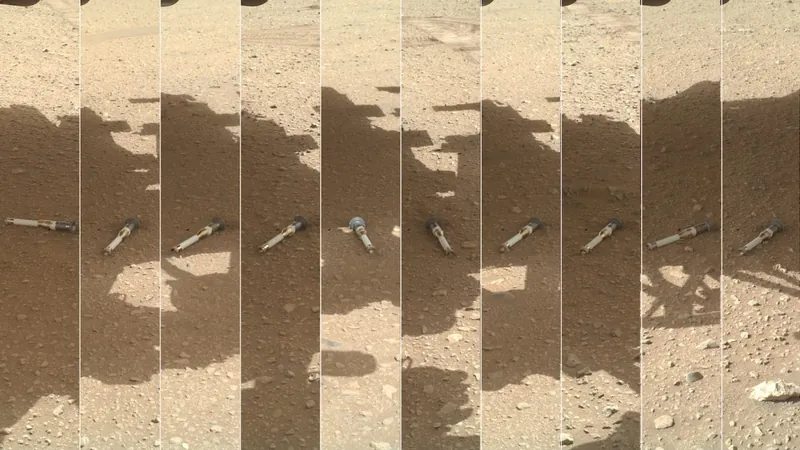
NASA's Mars Sample Return Decision Deferred: What's Next for the Red Planet?
2025-01-08
Author: Ming
For nearly four years, NASA's Perseverance rover has been trotting across an uncharted section of Mars, a once vibrant river delta, gathering an array of rock samples meticulously stored in titanium tubes. These capsules are key to unlocking potential secrets about ancient life on Mars, yet NASA has yet to solidify its plans for returning these precious samples to Earth.
Potential Pathways for Mars Sample Return (MSR) Mission
During a recent briefing, NASA officials introduced two potential pathways for the ambitious Mars Sample Return (MSR) mission. One relies on a traditional design, echoing the landing systems used in previous Mars missions, while the other considers collaboration with private space companies for the lander's development.
NASA Administrator Bill Nelson deferred the ultimate decision on the trajectory of the MSR to the next administration, under the incoming Trump presidency, with entrepreneur Jared Isaacman nominated as the new NASA head. Nelson noted that funding will largely dictate the direction of these plans: “This is going to be a function of the new administration in order to fund this.”
Trump Administration's Approach
The burning question remains: What approach will the Trump administration favor? Will they choose to send humans to Mars as a part of this mission, or will it remain solely robotic? Early signs suggest the upcoming White House aims to highlight rapid advancements and tangible outcomes in NASA's space initiatives, likely prioritizing a human landing on the Moon and aspirations for Mars exploration.
Budget Constraints and New Proposals
NASA's previous strategy for transporting Mars samples has been halted by budget constraints, with an independent review indicating the mission could cost up to $11 billion and wouldn’t have the samples back on Earth until 2040. This financial impasse forced NASA to invite proposals from a range of entities—government labs, research institutions, and commercial firms—in search of an alternative, affordable way to recover the approximately 30 rock samples stored on Perseverance.
In a shift towards a more economical approach, Nelson revealed that the Jet Propulsion Laboratory (JPL) has proposed a new plan, likely costing between $6.6 billion and $7.7 billion. This fresh architecture would eliminate the need for a “fetch rover,” relying instead on Perseverance to deliver samples directly to the lander.
However, an alternative idea suggests utilizing a commercial heavy lander that could potentially bring the cost down to between $5.1 billion and $7.1 billion. JPL is poised to play a critical role in both proposed strategies, providing expertise that is essential for success.
Funding Approval from Congress
Receiving funding approval from Congress for the MSR project will be pivotal; Nelson has asked for $300 million in this year’s budget to keep the project moving forward. If Congress grants this request, the timeframe to bring samples back to Earth could be as soon as 2035, although some estimates extend that to as late as 2039.
Scientific Community's Urgent Call
The scientific community has marked the Mars Sample Return mission as the highest priority for NASA's planetary science program. Indeed, in a 2022 report by the National Academies, researchers urged continued investment in MSR to avoid jeopardizing other planetary missions.
However, challenges remain acute amidst budget constraints and competing priorities. Notably, the Planetary Society has expressed concern regarding the ongoing delays in decision-making about the MSR program, emphasizing that it’s time for NASA to set forth a definitive plan for securing the samples collected by Perseverance.
Global Competition and Future Implications
To compound the urgency, China is also planning a mission named Tianwen-3, aimed at returning Mars samples by 2031. With competing timelines and methodologies, there is growing concern about the implications of a global “space race” for resources and scientific discovery related to Mars.
In anticipation of future exploration, researchers stress that analyzing these Martian samples in terrestrial labs holds the potential to yield vital insights into the history of the solar system and whether Mars may have once harbored life. The race is on—not only for the samples but for our understanding of the cosmos.
Conclusion
The next phases of the Mars Sample Return mission hinge on political will, financial backing, and scientific ambition—elements that will shape the future of Mars exploration and potentially redefine humanity's journey into outer space. Can the next administration rise to the occasion? Only time will tell.

 Brasil (PT)
Brasil (PT)
 Canada (EN)
Canada (EN)
 Chile (ES)
Chile (ES)
 Česko (CS)
Česko (CS)
 대한민국 (KO)
대한민국 (KO)
 España (ES)
España (ES)
 France (FR)
France (FR)
 Hong Kong (EN)
Hong Kong (EN)
 Italia (IT)
Italia (IT)
 日本 (JA)
日本 (JA)
 Magyarország (HU)
Magyarország (HU)
 Norge (NO)
Norge (NO)
 Polska (PL)
Polska (PL)
 Schweiz (DE)
Schweiz (DE)
 Singapore (EN)
Singapore (EN)
 Sverige (SV)
Sverige (SV)
 Suomi (FI)
Suomi (FI)
 Türkiye (TR)
Türkiye (TR)
 الإمارات العربية المتحدة (AR)
الإمارات العربية المتحدة (AR)